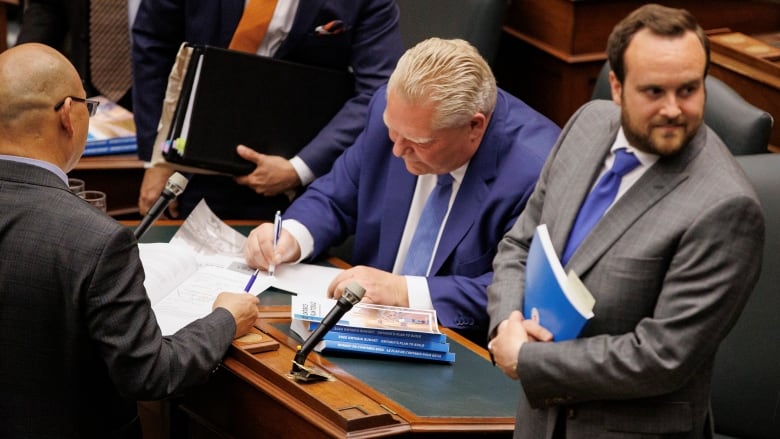
On April 28, Ontario’s Minister of Finance, the Honourable Peter Bethlenfalvy released Ontario’s 2022 Budget: Ontario’s Plan to Build.
The Ontario Society of Professional Engineers (OSPE) was invited as a key stakeholder to be part of the consultation process undertaken by the government prior to the release of the budget.
Ontario Budget 2022 builds on the foundation of several pillars:
- Rebuilding Ontario’s Economy
- Working for Workers
- Building Highways and Key Infrastructure
- Keeping Costs Down
- A Plan to Stay Open
The Government of Ontario is projecting steadily declining deficits of $19.9 billion in 2022–23, $12.3 billion in 2023–24, and $7.6 billion in 2024–25.
Ontario’s real GDP is projected to increase by 3.7 per cent in 2022 and 3.1 per cent in 2023. Growth is expected to moderate to 2.0 per cent in 2024 and 1.9 per cent in 2025
OSPE has identified the following areas of Budget 2022 that are of most interest to our membership:
- To connect communities, fight gridlock and keep goods and people moving, the government is investing $25.1 billion over the next 10 years to support the planning and/or construction of highway expansion and rehabilitation projects across the province, including the construction of Highway 413 and the Bradford Bypass, as well as the expansion of Highway 401.
- Ontario is investing $61.6 billion over 10 years for public transit, including Ontario’s new subway transit plan for the Greater Toronto Area (GTA) and transforming the GO Transit network into a modern, reliable and fully integrated rapid transit network.
- Through the Ontario Community Infrastructure Fund (OCIF), the government doubled its annual investment to nearly $2 billion over five years, beginning in 2021–22, to help 424 small, rural and Northern communities construct and rehabilitate roads, bridges, water and wastewater infrastructure
IMPACT:
OSPE agrees that funding infrastructure projects is a beneficial, long-term investment. However, given that funding is finite, OSPE believes money must be spent wisely and hard decisions need to be made in terms of which infrastructure projects get approved. OSPE stresses to all levels of government that key decisions on infrastructure should be evidence-based and made in consultation with engineers.
OSPE believes that Ontario should develop a transparent framework that informs how infrastructure projects will be prioritized, sequenced, and funded, including the mechanisms and models for funding. Ideally, this framework would be jointly developed by all levels of government, industry participants, community organizations, and other interested parties.
Engineers believe that the COVID-19 pandemic provides an opportunity to invest in infrastructure as a key method that will drive economic growth in Ontario. However, mistakes of the past should not be repeated. Infrastructure projects should:
- Make use of a Qualifications Based Selection (QBS) framework: given Ontario’s current economic and fiscal situation, it is essential that all public infrastructure investments be transparent and return the greatest possible value for money. By adopting Qualifications-Based Selection (QBS) as its best practice for the selection of consultants, the government can realize the greatest possible value for investment in its infrastructure projects. QBS is the smartest tool to ensure post-COVID-19 economic recovery throughout Ontario.
- Effectively report life-cycle costing: it is essential that all infrastructure projects conducted by the province properly report and consider life-cycle costing. To gain the maximum value for money, all costs incurred over the whole life span of infrastructure projects must be estimated. This will ensure that taxpayer’s money is used for infrastructure projects that are able to produce multigenerational benefits for most Ontarians at a proper cost.
- Consider diversity and inclusion: the provincial government should implement supply chain diversity policies. This will enable the province to use procurement to advance equity, diversity, and inclusion.
Engineers must also stress the need for infrastructure projects to be sustainable for current and future generations. Unfortunately, Highway 413 and the Bradford Bypass are not sustainable projects. These should be cancelled.
- In March 2022, the Ontario government released the province’s first‐ever Critical Minerals Strategy, a five‐year road map that will help strengthen Ontario’s position as a global leader in supplying critical minerals and Ontario’s supply chain for electric and hybrid vehicle manufacturing.
- The Ontario government is investing $2 million in 2022–23 and $3 million in 2023–24 to create a Critical Minerals Innovation Fund to support the mining industry, academia, startups and research and development firms to find innovative solutions for extraction and processing of critical minerals.
- In April 2022, Ontario released its Low‐Carbon Hydrogen Strategy to accelerate the development of the low‐carbon hydrogen economy in the province that will create jobs, attract investment and reduce emissions.
- Ontario Power Generation is working to deploy Canada’s first grid‐scale Small Modular Reactor (SMR) as early as 2028, which would add clean, affordable and reliable energy to Ontario’s electricity grid, attract investment, and support good‐paying jobs in the nuclear sector for decades to come.
IMPACT: OSPE had the opportunity of providing comments during the Government’s consultation period regarding its Critical Mineral Strategy. OSPE is glad the Government of Ontario listened to engineering recommendations when developing their strategy. Engineers are key for this sector to flourish. OSPE is particularly pleased to see that the government is committed in investing in research and development, as well as developing programs that focus on the alternative use of “waste streams” and “post closure” assets to support environmental stewardship and sustainability.
- Ontario is supporting investments to help make the province a world‐leading producer of clean low‐emission steel to help build the hybrid and electric vehicles of the future.
- The Ontario government is providing $91 million to help make electric vehicle (EV) chargers more accessible to the public across the province. The funding will add more EV chargers across Ontario, including highway rest stops and in community hubs like hockey arenas, carpool lots, and provincial and municipal parks.
IMPACT: As Ontario historically has been a leader in automotive manufacturing, OSPE is pleased that the government is recognizing the importance of investing in electric vehicles (EVs). However, although this is a positive first step, OSPE believes that more can be done. The Ontario government cancelled the EV incentive program, which resulted in a 53 per cent decrease of EV purchases in the first half of 2019. Ontario is the only province in Canada not experiencing an increase in EV sales. With the current pandemic, the government has the opportunity of rectifying this decision, and supporting a clean growing sector right here in our province.
Some of the uptake barriers encountered with EVs, such as a shorter range, longer recharge times, and a higher upfront cost can be addressed by smart government action. Some jurisdictions, like California, have committed to achieving a “tipping point” of electric vehicle adoption by enacting EV sale mandates requiring automakers to sell a specified number of EVs per year, as a percentage of sales. In Quebec, such action has resulted in a 131 per cent increase in one year.
To ensure Ontario accelerates the electrification of its transportation system, the province should:
- Work with the federal and municipal governments to allocate specific resources to the electrification of the public transportation system.
- Develop and implement an incentive program for electric vehicles, until mass adoption “tipping point” is achieved.
- Enact an EV sales mandate like the ones established in Quebec and California, requiring automakers to sell a minimum percentage of electric vehicles.
Besides this, OSPE is disappointed to see that Budget 2022 does not properly address one of society’s biggest concerns: climate change.
- Ontario is investing an additional $114.4 million over three years in its Skilled Trades Strategy to break the stigma associated with the skilled trades, simplify the system and encourage employer participation
- the Ontario government is raising the general minimum wage to $15.50 per hour on October 1, 2022.
IMPACT: OSPE is pleased that the government understands the need to invest in training its workforce. We commend the focus on an integrated, multi-phased approach that equips more people with the skills needed to get quality jobs through apprenticeships. However, more should be done to ensure that engineers, and not only tradespeople have access to these opportunities. As engineers lead the design aspects of many projects across these sectors, without supporting engineers in upskilling and keeping up with evolving trends, it will be very difficult to innovate in the province. This inability to innovate within these sectors will mean a loss of opportunities for new job creation for both professionals and tradespeople.
- Supporting Futurpreneur Canada for innovation, jobs, and economic growth by investing $2M in 2022-23 to give entrepreneurs the tools required to pursue business ownership and grow into successful companies
- Investing $10M over 2022-23 and 2023-24 to create a new Digitization Competence Centre, in collaboration with the Ontario Centre of Innovation with the purpose of providing small businesses with the training and support to use new equipment and processes, helping them understand and adopt digital technologies
IMPACT: Investing in the province’s research and innovation resources enables local talent to contribute to economic prosperity. Substantial investments in innovation creates an opportunity to leverage competitive products on a global stage and bolsters Ontario’s attraction to high-level international talent. The Ontario government has created a space for research and innovation to happen and OSPE hopes continuous, fruitful investment continues.
- Helping innovators protect and commercialize their intellectual property by creating Intellectual Property Ontario with a $58M investment over 3 years. This will serve as a resource for IP expertise to help researchers maximize their IP value and strengthen their capacity to grow and compete globally.
IMPACT: Research has shown acquiring IP provides businesses with a strong portfolio that sets them up for success. It is necessary to create a path for businesses to file and acquire IP on their innovations to keep Ontario businesses open and competitive. While this investment is of great value, OSPE hopes to see the Ontario government create lucrative opportunities for our businesses and entrepreneurs to excel.
Boosting Canada’s Innovation Ecosystem and Promoting Innovation Investments
- Enhancing postsecondary education and training for Indigenous learners by Investing $9M over 3 years to support 9 Indigenous governed and operated Indigenous Institutes
- The Indigenous Institutes’ operating grant to expand postsecondary program offerings including new, independently delivered programs to train more Indigenous learners. This will promote a greater diversity of programs that meet the economic, health and social needs of Indigenous communities.
- The Indigenous Institutes capital grant to bring equitable access for facility renewal funding. This investment would support capital repairs and renovations to accommodate additional programs and students.
- Creating economic opportunities for women by providing $6.9M over 3 years to enhance the Investing in Women’s Futures program
- Enhancing the Ontario Immigrant Nominee Program
- Investing $15.1M over 3 years in OINP, a nomination system for permanent residences who have skills that match provincial labour market needs
- Removing barriers for Internationally Trained Workers, removed several months ago, additionally investing $67M over 3 years for Ontario Bridge Training Program to match immigrants within demand jobs in their communities
IMPACT: OSPE is pleased to see investments aimed at creating an equitable system for all people to participate in. Budget 2022 shows the Ontario Government is commitment to investing in our economy by enabling all individuals to participate. Our Indigenous communities have been left behind for far too long and meaningful investments are long overdue. Women make up an essential portion of the workforce that enable our economy to thrive. Internationally trained professionals, including engineers, are of incredible talent that Ontario can capitalize on. OSPE is looking forward to having these investments spent and seeing the effects they have on our communities.
For more on what we thought the Budget should focus on, read our 2022 Pre-Budget Submission
What did you think of Ontario Budget 2022? How will it impact you as an engineer and Ontarian?





